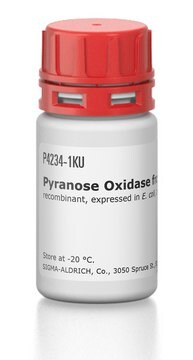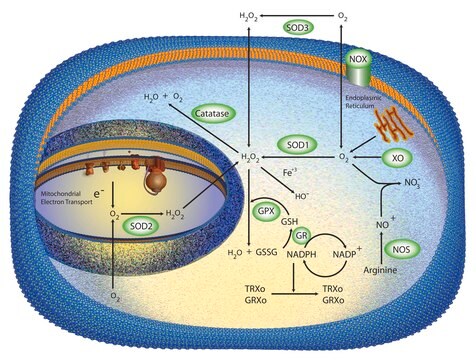C40
Catalase from bovine liver
lyophilized powder, ≥10,000 units/mg protein
Sinónimos:
H2O2:H2O2 oxidoreductase
About This Item
Productos recomendados
formulario
lyophilized powder
Nivel de calidad
actividad específica
≥10,000 units/mg protein
mol peso
tetramer ~250 kDa
contiene
≤0.2 wt. % Thymol
punto isoeléctrico
5.4
solubilidad
50 mM potassium phosphate buffer, pH 7.0: soluble 2.0 mg/mL
Nº de acceso UniProt
Condiciones de envío
wet ice
temp. de almacenamiento
−20°C
InChI
1S/C9H10O3/c1-2-12-9(11)7-3-5-8(10)6-4-7/h3-6,10H,2H2,1H3
Clave InChI
NUVBSKCKDOMJSU-UHFFFAOYSA-N
Información sobre el gen
cow ... CAT(280743)
¿Está buscando productos similares? Visita Guía de comparación de productos
Descripción general
Catalase from bovine liver is a tetramer consisting of 4 equal subunits each with a 60 kDa molecular weight. Each of these subunits contains iron bound to a protoheme IX group. The enzyme will also strongly bind to NADP, where NADP and the heme group are within 13.7 angstroms.
Aplicación
Catalase from bovine liver may be used:
- to prepare H2O2-O2 based biocathode for applications in glucose biofuel cells
- to study the kinetic properties and storage stability of catalase immobilized on to florisil
- in glutathione-mediated superoxide generation in an aqueous solution
Acciones bioquímicas o fisiológicas
Precaución
Definición de unidad
Otras notas
inhibidor
Palabra de señalización
Danger
Frases de peligro
Consejos de prudencia
Clasificaciones de peligro
Resp. Sens. 1
Código de clase de almacenamiento
11 - Combustible Solids
Clase de riesgo para el agua (WGK)
WGK 1
Punto de inflamabilidad (°F)
Not applicable
Punto de inflamabilidad (°C)
Not applicable
Equipo de protección personal
Eyeshields, Gloves, type N95 (US)
Certificados de análisis (COA)
Busque Certificados de análisis (COA) introduciendo el número de lote del producto. Los números de lote se encuentran en la etiqueta del producto después de las palabras «Lot» o «Batch»
¿Ya tiene este producto?
Encuentre la documentación para los productos que ha comprado recientemente en la Biblioteca de documentos.
Los clientes también vieron
Protocolos
This procedure may be used for all Catalase products.
Nuestro equipo de científicos tiene experiencia en todas las áreas de investigación: Ciencias de la vida, Ciencia de los materiales, Síntesis química, Cromatografía, Analítica y muchas otras.
Póngase en contacto con el Servicio técnico














